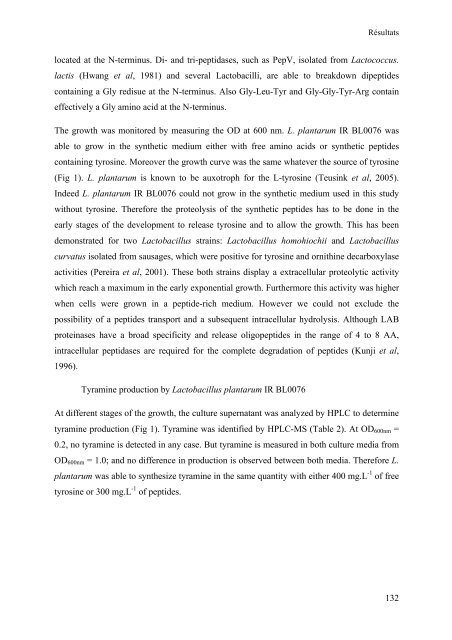THESE Maryse Bonnin Jusserand - Université de Bourgogne
THESE Maryse Bonnin Jusserand - Université de Bourgogne
THESE Maryse Bonnin Jusserand - Université de Bourgogne
Create successful ePaper yourself
Turn your PDF publications into a flip-book with our unique Google optimized e-Paper software.
Résultats<br />
located at the N-terminus. Di- and tri-peptidases, such as PepV, isolated from Lactococcus.<br />
lactis (Hwang et al, 1981) and several Lactobacilli, are able to breakdown dipepti<strong>de</strong>s<br />
containing a Gly redisue at the N-terminus. Also Gly-Leu-Tyr and Gly-Gly-Tyr-Arg contain<br />
effectively a Gly amino acid at the N-terminus.<br />
The growth was monitored by measuring the OD at 600 nm. L. plantarum IR BL0076 was<br />
able to grow in the synthetic medium either with free amino acids or synthetic pepti<strong>de</strong>s<br />
containing tyrosine. Moreover the growth curve was the same whatever the source of tyrosine<br />
(Fig 1). L. plantarum is known to be auxotroph for the L-tyrosine (Teusink et al, 2005).<br />
In<strong>de</strong>ed L. plantarum IR BL0076 could not grow in the synthetic medium used in this study<br />
without tyrosine. Therefore the proteolysis of the synthetic pepti<strong>de</strong>s has to be done in the<br />
early stages of the <strong>de</strong>velopment to release tyrosine and to allow the growth. This has been<br />
<strong>de</strong>monstrated for two Lactobacillus strains: Lactobacillus homohiochii and Lactobacillus<br />
curvatus isolated from sausages, which were positive for tyrosine and ornithine <strong>de</strong>carboxylase<br />
activities (Pereira et al, 2001). These both strains display a extracellular proteolytic activity<br />
which reach a maximum in the early exponential growth. Furthermore this activity was higher<br />
when cells were grown in a pepti<strong>de</strong>-rich medium. However we could not exclu<strong>de</strong> the<br />
possibility of a pepti<strong>de</strong>s transport and a subsequent intracellular hydrolysis. Although LAB<br />
proteinases have a broad specificity and release oligopepti<strong>de</strong>s in the range of 4 to 8 AA,<br />
intracellular peptidases are required for the complete <strong>de</strong>gradation of pepti<strong>de</strong>s (Kunji et al,<br />
1996).<br />
Tyramine production by Lactobacillus plantarum IR BL0076<br />
At different stages of the growth, the culture supernatant was analyzed by HPLC to <strong>de</strong>termine<br />
tyramine production (Fig 1). Tyramine was i<strong>de</strong>ntified by HPLC-MS (Table 2). At OD600nm =<br />
0.2, no tyramine is <strong>de</strong>tected in any case. But tyramine is measured in both culture media from<br />
OD600nm = 1.0; and no difference in production is observed between both media. Therefore L.<br />
plantarum was able to synthesize tyramine in the same quantity with either 400 mg.L -1 of free<br />
tyrosine or 300 mg.L -1 of pepti<strong>de</strong>s.<br />
132

















